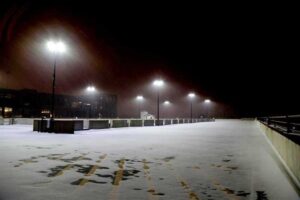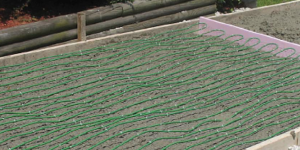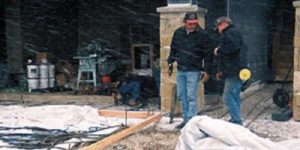If you live above the Mason-Dixon line, chances are your winter months are cold and snowy. It’s great weather for skiing, but not so much for those who work with concrete.
“Here in New England it means we stop installing exterior decorative concrete systems usually around the end of October and we can’t start up again until sometime in March or April,” says Bill Guthro of Distinctive Concrete in Rowley, Mass. That’s not quite as bad as in Winnipeg, Ont., where, Randy Klassen of Klassen Concrete says, the ground freezes up to seven feet deep and outdoor concrete work often can’t begin again until May.
“Here we only can do outdoor concrete work six months out of the year,” says Klassen, “so you have to line up inside work.”
 Chris Becker, owner of Becker Architectural Concrete in South St. Paul, Minn., says he begins planning ahead for winter as much as he can in the summer months. “About 40 percent of our work is countertops, sinks and indoor floors,” he explains. “When people come to me in the summer with those types of jobs, I ask them if they’d be willing to wait for the winter months. If they do, I seasonally price the work and offer a discount for inside work during the winter.”
Chris Becker, owner of Becker Architectural Concrete in South St. Paul, Minn., says he begins planning ahead for winter as much as he can in the summer months. “About 40 percent of our work is countertops, sinks and indoor floors,” he explains. “When people come to me in the summer with those types of jobs, I ask them if they’d be willing to wait for the winter months. If they do, I seasonally price the work and offer a discount for inside work during the winter.”
“You have to offer a wide range of services to enable your company to make it through the winter months,” says Guthro. “Our exterior installations include stamped concrete and overlays. Our interior installations include acid-stained floors, polished concrete, microtoppings and concrete countertops. The winter season is also a great time to invest in decorative concrete seminars.”
Getting over the hurdles
Even working indoors presents challenges during the winter. “Outdoor climates will affect what happens indoors,” says Klassen. “Sometimes it gets so cold here the furnace will run nonstop all day and it dries everything out.” In addition, he says, when doing sealing projects, “you have to extinguish the pilot lights in the building.”
For Guthro, logistics are his biggest winter challenge. “Like most old cities, many of Boston’s streets are very narrow with little or no parking — and that’s during the summer. An 8-inch snowstorm only makes it worse.” He’s learned to add the $100 parking tickets into the cost of the job.
Guthro’s business has evolved over the years and much of his work is now indoors year round, which he says has been good for his employee retention. “When you diversify and are able to work on interior jobs and exterior jobs, you’re more likely to stay busy most of the year and retain the same crew. Anytime you’ve got an employee working inside a heated space in February or an air-conditioned space in August, you’ve got a happy employee.”
Klassen and Becker, however, have found other ways to adapt. Klassen’s strategy is to hire a lot of university students for his busy summer periods. “They are going back to school anyway when the cold weather comes,” he says. His full-time crew splits their time between indoor concrete work and snow removal. “A lot of concrete people here do snow removal in the winter.”
Becker’s strategy of looking for indoor work paid off big this year, as he was contracted to do the floors of a 100-unit loft project, with an upgrade option for countertops. However, Becker says he has found the best solution yet to handling work in the winter.
“As our company gets more known for our high-end product, we’re being sought out to do jobs in other parts of the country,” he says. “We have a job in Arizona and one in Hawaii.”

















